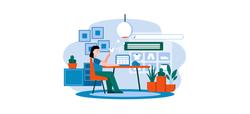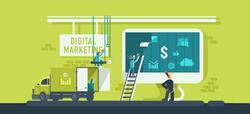After building your online store, the next step is to market your products, gain traffic, and, eventually, secure conversions. There are many simple, affordable and accessible hacks to marketing your online store, even if you are new to selling. How?
Digital Marketing!
Introduction
Digital Marketing refers to marketing through all digital channels such as email, social media, content marketing, mobile networks and search engines.
You do not have to be a marketing expert to be successful in Digital Marketing. As long as you are well-informed about your target audience and your product, you can be strategic in selecting which tools are best suited for your needs.
We created this infographic to get you up to date with all the Social Trends:

Content Marketing
Content marketing is the process of creating and distributing high-quality, relevant content at a consistent pace in order to attract and retain an interested audience. The ultimate goal? Generating conversions through a process of informing.
Creating your own content is one proven method for driving traffic to your website in order to move up Google ranks. It’s also one of the cheapest strategies to get traffic, you only need to invest time into writing about your industry.
Start by investigating what your target audience is looking for. Buyers usually spend time researching many products before purchasing. During the research phase of a buyer’s decision-making process, your content should help guide and inform them.
Beyond helping potential and current customers, informative content, like blogs, can significantly improve brand-awareness, and, over time, you will reap the rewards of high-quality blogging: many visitors will turn to you for not only great content, but also your expertise.
Search Engines
Using a search engine in your favor is a great strategy for securing traffic. Currently, 93% of all web traffic comes through search engines. While there are many search engines, no ranking status is quite as important as how your store ranks in Google search.
Google’s search engine displays two types of ranking formats that are important to understand: organic and paid results. Ranking high in organic results requires high-quality content and web traffic over time. Paid results place your specific links above others’ in Google search using Google Ads; however, extensive use can be expensive. In our opinion, it is best to build a strong organic foundation, and then use paid ads to gain an edge over your competitors.
Tip: Google Adwords, Bing Ads, and Facebook offer coupons frequently to test their platforms.
Search Engine Optimization
Nowadays a beautiful online storefront and positive shopping experience is simply not enough to convert customers. If your target audience cannot find your site on Google, why (or, how, really) would they shop for your products?
Unfortunately, while many people use search engines like Google to search for products and services, research shows that websites on the first search engine results page receive almost 95% of web traffic. With the help of SEO, you can improve the ranking of your website, giving it a better chance of being visited.
Keep in mind that the results will not be instant. During the first months, you will usually rank low. Search engines, like Google, have to index your store, crawl your website content, and then use algorithms to determine the relevance and helpfulness of your site information. Over time, by building great content and having links from external websites, your ranking will increase.
Want to learn more about SEO? Read our guide here.
Conversion Rate Optimization
To make a profit, the most important thing is to get conversions! There are different types of conversions, the ideal one, of course, is for visitors to make a purchase. Strikingly, however, customer conversion rates for online purchases are only 1% - 3%.
However, there are other goals you can set for visitors to complete on your website that would later lead to a purchase being completed: free trial sign-ups, newsletter subscriptions, or social media actions.
When thinking about optimizing conversion rates you must know the what, where and who. Meaning, what to optimize, where to optimize it and who are you optimizing it for? In order to answer these questions, you must have data.
Collecting data can give you a lot of insight into your audience and you can target them better. One of the most popular methods is to do A/B testing in your store, in order to make your landing page optimized to get better conversions.
Social Media
Due to its vast reach and affordability, social media can transform your business—even with a small marketing budget. But that means vicious competition on sites like Facebook, Twitter, Instagram, and LinkedIn.
On social media, creative, original content garners the most attention. There are many tools that can be used to create visually attractive and targeted posts, like Canva, Stencil, and Pixlr. No matter your strategy, mix it up! Use GIFs, images, and videos. And, no matter the temptation: do not repeat your posts!
Learn more about the best social media strategies here.
Youtube
Youtube is a great way to reach out to potential customers. We recommend creating your own channel, rather than purchasing expensive paid Youtube ads. On your channel, you can share knowledge about your product’s industry, as well as provide instructional videos if your products require additional explanation.
However, focus on quality rather than quantity: instead of having hundreds of videos on your channel, only have 10 or 15 high-quality videos. Your videos should be professionally edited as well as presented. By doing so, you’ll rack up more views while also creating a brand-image for your company.
Q&A Forums
Despite being great methods for driving traffic to your website, Reddit and Quora are often overlooked. Participating in conversations and Q&As is a lead-gen goldmine. These sites’ communities, in which users ask each other questions and provide answers to topics, are invaluable to any marketer or online shop-owner.
No matter if you’re selling dog collars or baking trays, more than likely it has been discussed on these sites. Search for your shop’s products, and see if there are any relevant conversations you can contribute to. Make sure to link to your store, or at least put it in your bio! Q&A forums not only help you obtain potential customers, but also help associate your particular product or service with your brand name.
After spending a bit of time and research (Reddit and Quora are completely free), you will see improved Google results as well as conversions.
Influencer Marketing
Influencers are people who have a strong presence on social media, and use that presence to influence audiences. Unlike celebrity endorsements, social media influencers usually have a large following/reach in a niche market.
Companies often use Influencer Marketing Campaigns to boost brand recognition and spread the word about their product/service, leading to potential customers. The influencer campaign should align with the larger content strategy and image of your company. To do so, determine the goals you want to achieve from that campaign and track metrics such as audience reach, views, engagement, follower increase, and sales. By using data, you will be able to understand the impact of your influencer campaign.
Before choosing an influencer, do your research and make sure that he/she is the perfect fit. Try out a platform like Klear to connect with suitable social influencers. It’s best to trust in the influencer’s creative direction, as they know their audience best.
Read more on our approach to influencer marketing here.
Email Marketing
Email marketing is one of the most effective marketing strategies. Lifecycle emails are the simplest way to implement an email marketing strategy. This automated technique takes effect after a customer has completed an action, like signing up for a newsletter, purchasing an item, or abandoning their cart.
Curated, automated emails inform them of upcoming promotions, order overviews, or remind the customer to complete their purchase.
Schema.org is a fantastic email markup tool. Users can make direct interactions, take action, or view information without even having to search the email’s content. Look into Mailchimp, Marketo, Sendgrid or Hubspot to learn more about automated email tools.
Backlinks & Inbound Marketing
We’ve talked about the importance of organic traffic and original content. Backlinks and inbound marketing combine content and your target audience in order to gain organic referral traffic – sources other than your online store or search engines.
How is this possible?
By posting your content on relevant, external, high-quality pages, you can redirect users to come to your online store. When potential customers come across a particular article, video, or podcast that contains a strategically-placed link, these users will most likely visit your site. Some popular sources include:
-
Blogs and articles
-
Webinars
-
Demonstration Videos
-
Infographics
-
Podcasts
Guest-posting is an advised strategy for building strong backlinks, just make sure you are targeting your intended niche. For instance, if you are selling high-quality kitchen knives, you’d want to guest-post on a cooking blog – not a furniture site.
Learn more about inbound marketing strategies here.
Affiliates
Another method for racking up some traffic and conversions is affiliate marketing. And, thankfully, it sounds more complicated than it is!
Generally, your store, product, or service is recommended by a third-party. If a visitor to that third-party site purchases from your online store, the recommender is rewarded.
There are many ways to create an affiliate program: using a unique code to refer traffic to the target site, text-links, and banners.
The code only has to be copied and placed on the partner/affiliate website to start referring traffic. Once the referral system is in place, all you have to do is sit back and watch the traffic come in.
Need an example? Check out our referral program here.
Mobile Marketing
In the future, mobile marketing will outgrow desktop marketing outlets. Right now, mobile devices are used for over 40% of online transactions. In order to reach the target audience on their smartphones, tablets, and/or other mobile devices, you need to devise a clear strategy. Take the following optimization
-
Mobile website development
-
Mobile email optimization
-
SMS marketing
-
Mobile-first social media
-
Mobile-based apps
Balancing budgets, running parallel campaigns, A/B testing, digital marketing can be a nightmare. Even a successful, large-scale, online store like Amazon has difficulty with these 12 tools for selling online.
In order for your marketing to be most effective you must research the profiles of your ideal customers and where they spend their time online. This is called a “buyer persona”. Learn more about creating buyer personas here.
After you have acquired this data, you will have more insight to help inform which channels you should prioritize, which are worth your time and effort, and which platforms give sizable returns.






